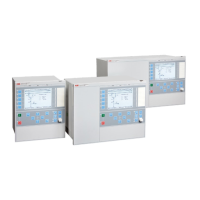3.12.1.1 Application
Synchronizing
To allow closing of breakers between asynchronous networks a synchronizing function
is provided. The breaker close command is issued at the optimum time when
conditions across the breaker are satisfied in order to avoid stress on the network and
its components.
The systems are defined to be asynchronous when the frequency difference between
bus and line is larger than an adjustable parameter. If the frequency difference is less
than this threshold value the system is defined to have a parallel circuit and the
synchronism check function is used.
The synchronizing function measures the difference between the V-Line and the V-
Bus. It operates and enables a closing command to the circuit breaker when the
calculated closing angle is equal to the measured phase angle and the following
conditions are simultaneously fulfilled:
• The voltages U-Line and U-Bus are higher than the set values for VHighBusSynch
and VHighLineSynch of the base voltages VBaseBus and VBaseLine.
• The difference in the voltage is smaller than the set value of VDiffSynch.
• The difference in frequency is less than the set value of FreqDiffMax and larger
than the set value of FreqDiffMin. If the frequency is less than FreqDiffMin the
synchronism check is used and the value of FreqDiffMin must thus be identical to
the value FreqDiffM resp FreqDiffA for synchronism check function. The bus and
line frequencies must also be within a range of +/- 5 Hz from the rated frequency.
When the synchronizing option is included also for autoreclose there is no reason
to have different frequency setting for the manual and automatic reclosing and the
frequency difference values for synchronism check should be kept low.
• The frequency rate of change is less than set value for both V-Bus and V-Line.
• The closing angle is decided by the calculation of slip frequency and required pre-
closing time.
The synchronizing function compensates for measured slip frequency as well as the
circuit breaker closing delay. The phase angle advance is calculated continuously.
Closing angle is the change in angle during the set breaker closing operate time
tBreaker.
The reference voltage can be phase-neutral A, B, C or phase-phase A-B, B-C, C-A or
positive sequence. The bus voltage must then be connected to the same phase or phases
as are chosen for the line. If different phases voltages are used for the reference
voltage, the phase shift has to be compensated with the parameter PhaseShift, and the
voltage amplitude has to be compensated by the factor URatio. Positive sequence
selection setting requires that both reference voltages are three phase voltages.
Section 3 1MRK504116-UUS C
IED application
580
Application manual

